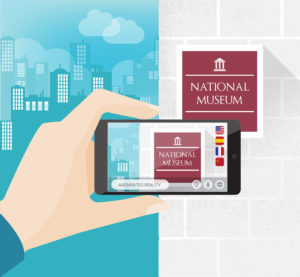It’s fair to say that augmented reality has moved from a cool technology that might be neat for students to try to a credible teaching tool that fits just as easily in K-12 classrooms as it does in higher education.
Advocates have long said augmented reality helps boost student engagement and also helps them connect what they’re learning to how they will use that knowledge in the real world. And as the technology grows, graduating students could find employment opportunities in the augmented reality sector, which has led schools to offer courses focused around the technology.
Augmented reality differs from virtual reality in that, while virtual reality creates a virtual or “fake” world, augmented reality overlays additional information and virtual features over the real, existing world.
The 2016 Horizon Report predicts that augmented reality is among the technologies and developments higher education institutions should take note of for its forthcoming influence on education.
“Augmented reality, the layering of data over 3D spaces to produce a new experience of the world, sometimes referred to as ‘blended reality,’ amplifies access to information, bringing new opportunities for learning,” according to the report.
During the spring of 2016, University of Maryland undergraduate and graduate students were part of the university’s first class in virtual reality, which is expected to generate more than $1 billion in sales this year. Students spent the semester learning the technical aspects of virtual reality and augmented reality.
“CMSC 498W: Introduction to Virtual and Augmented Reality” was offered through the university’s Department of Computer Science. It covered topics like generating virtual worlds, tracking and registering visual images, and digitally rendering haptics (interactives involving touch) and 3D audio.
Students also were tasked with designing virtual demos that they presented as final class projects, offering an array of visually immersive scenarios that included fighting a swarm of zombies, a virtual tour of the UMD campus and a sensor-laden glove that tracked human hand movements.
(Next page: More schools incorporating augmented reality, plus 5 tools to explore)
The University of Maryland also is home to the Virtual and Augmented Reality Laboratory, also known as the Augmentarium. The Augmentarium’s main technology is the highly popular Oculus Rift.
Augmented reality’s applications within learning could be limitless, because any concept with a special or physical component can be better understood through a student’s firsthand use of the technology, and would likely make learning even more interesting and exciting for most students, university representatives said.
Cogswell Polytechnical College has launched a new virtual reality and augmented reality certificate program, which addresses the development of content for both technologies.
The program is a six-course set of specialized classes that will be offered weekday evenings and weekends to accommodate the schedules of industry professionals. The certificate program provides professionals in the computer graphics industry the opportunity to join development teams that create virtual or augmented reality content.
Augmented reality tools include:
1. Layar
2. Aurasma
3. Blippbuilder
4. ARToolKit
5. Wikitude SDK
[Editor’s note: We have not reviewed the above tools.]
- 6 key cybersecurity hiring trends - July 3, 2025
- Digital innovation and human connection are reshaping higher ed - June 30, 2025
- Amid uncertainty, IT leaders outline priorities for higher ed - June 27, 2025
